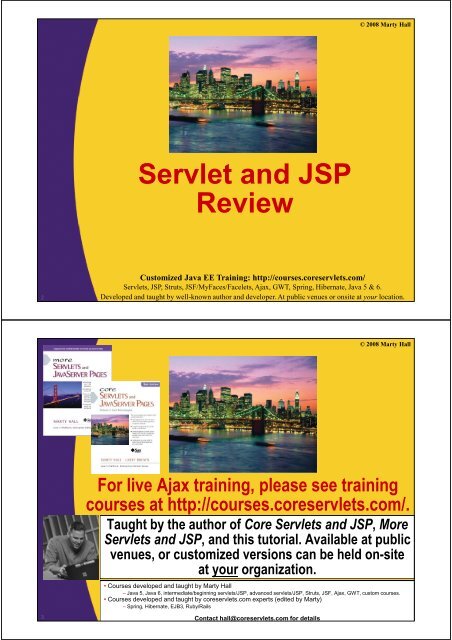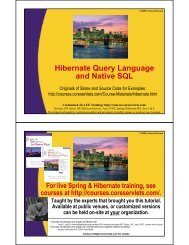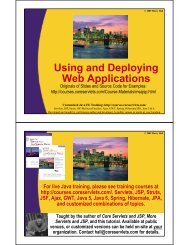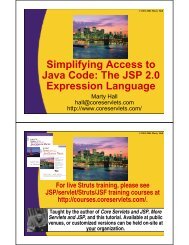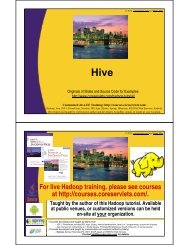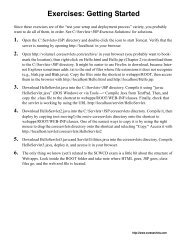0A-Servlet+JSP-Revie.. - Custom Training Courses - Coreservlets.com
0A-Servlet+JSP-Revie.. - Custom Training Courses - Coreservlets.com
0A-Servlet+JSP-Revie.. - Custom Training Courses - Coreservlets.com
You also want an ePaper? Increase the reach of your titles
YUMPU automatically turns print PDFs into web optimized ePapers that Google loves.
© 2008 Marty HallServlet and JSP<strong>Revie</strong>w2<strong>Custom</strong>ized Java EE <strong>Training</strong>: http://courses.coreservlets.<strong>com</strong>/Servlets, JSP, Struts, JSF/MyFaces/Facelets, Ajax, GWT, Spring, Hibernate, Java 5 & 6.Developed and taught by well-known author and developer. At public venues or onsite at your location.© 2008 Marty Hall3For live Ajax training, please see trainingcourses at http://courses.coreservlets.<strong>com</strong>/.Taught by the author of Core Servlets and JSP, MoreServlets and JSP, and this tutorial. Available at publicvenues, or customized versions can be held on-siteat your organization.• <strong>Courses</strong> developed and taught by Marty Hall– Java 5, Java 6, intermediate/beginning servlets/JSP, advanced servlets/JSP, Struts, JSF, Ajax, GWT, custom courses.• <strong>Courses</strong> developed <strong>Custom</strong>ized and taught Java by coreservlets.<strong>com</strong> EE <strong>Training</strong>: experts http://courses.coreservlets.<strong>com</strong>/(edited by Marty)– Servlets, Spring, Hibernate, JSP, Struts, EJB3, JSF/MyFaces/Facelets, Ruby/RailsAjax, GWT, Spring, Hibernate, Java 5 & 6.Developed and taught by well-known author and developer. At public venues or onsite at your location.Contact hall@coreservlets.<strong>com</strong> for details
Agenda• What servlets are all about• Servlet basics• Creating and deploying projects• Creating forms and reading form data• JSP scripting• Using XML syntax for JSP pages• JSP file inclusion• MVC4Java EE training: http://courses.coreservlets.<strong>com</strong>© 2008 Marty HallServlet Basics5<strong>Custom</strong>ized Java EE <strong>Training</strong>: http://courses.coreservlets.<strong>com</strong>/Servlets, JSP, Struts, JSF/MyFaces/Facelets, Ajax, GWT, Spring, Hibernate, Java 5 & 6.Developed and taught by well-known author and developer. At public venues or onsite at your location.
A Sample Servlet (Code)package coreservlets;import java.io.*;import javax.servlet.*;import javax.servlet.http.*;8public class HelloServlet2 extends HttpServlet {public void doGet(HttpServletRequest request,HttpServletResponse response)throws ServletException, IOException {response.setContentType("text/html");PrintWriter out = response.getWriter();String docType ="\n";out.println(docType +"\n" +"Hello (2)\n"+"\n" +"Hello (2)\n" +"");}}Java EE training: http://courses.coreservlets.<strong>com</strong>A Sample Servlet (Result)Assumes Eclipse project named intro. Code in src/coreservlets/HelloServlet2.java.If you make the web.xml entries from the up<strong>com</strong>ing slides, you could also usethe URL http://localhost/intro/hi29Java EE training: http://courses.coreservlets.<strong>com</strong>
© 2008 Marty HallTesting withEclipse10<strong>Custom</strong>ized Java EE <strong>Training</strong>: http://courses.coreservlets.<strong>com</strong>/Servlets, JSP, Struts, JSF/MyFaces/Facelets, Ajax, GWT, Spring, Hibernate, Java 5 & 6.Developed and taught by well-known author and developer. At public venues or onsite at your location.Installing Eclipse• Overview– Eclipse is a free open-source development environmentwith support for Java and many other languages• Downloading– http://www.eclipse.org/downloads/• Choose "Eclipse IDE for Java EE Developers"• As of 8/2008, version 3.4, called Eclipse Ganymede• Installing– Unzip into directory of your choice– Put shortcut to eclipse.exe on your desktop• Integrating Tomcat in Eclipse– http://www.coreservlets.<strong>com</strong>/Apache-Tomcat-Tutorial/eclipse.html11Java EE training: http://courses.coreservlets.<strong>com</strong>
Configuring Eclipse12• Make sure Eclipseknows about Tomcat– Click on Servers tab at bottom.R-click in window.– New, Server, Apache, Tomcat v6.0,Next, navigate to folder, Finish.• Suppress unnecessary<strong>com</strong>piler warnings– Window Preferences Java Compiler Errors/Warnings• Change "Serializable classwithout ..." to "Ignore"Java EE training: http://courses.coreservlets.<strong>com</strong>Making Web Apps in Eclipse• Make empty project– File New Project Web Dynamic Web Project– Give it a name (e.g., "test")– Accept all other defaults• Shortcut– If you have made DynamicWeb Project recently inworkspace, you can just doFile New Dynamic Web Project13Java EE training: http://courses.coreservlets.<strong>com</strong>
Adding Code to Eclipse Projects14• Locations– src• Unpackaged Java code• Packages strongly re<strong>com</strong>mended– src/somePackage• Java code in somePackage package– WebContent• Web files (HTML, JavaScript,CSS, JSP, images, etc.)– WebContent/some-subdirectory• Web content in subdirectory– WebContent/WEB-INF• web.xml (will be discussed later)• Can also click on“Deployment Descriptor”• Note– Can cut/paste or drag/drop files into appropriate locationsJava EE training: http://courses.coreservlets.<strong>com</strong>Starting Server in Eclipse15• Start Tomcat– Select “Servers” tab at bottom– R-click on Tomcat– Choose “Start”• Verify server startup– Open browser– Enter http://localhost/• You should see blank directory listing– If you want pretty Tomcatwel<strong>com</strong>e page, search for afolder called ROOT in yourEclipse workspace.Copy files fromC:\tomcat-dir\webapps\ROOTto that folderJava EE training: http://courses.coreservlets.<strong>com</strong>
Deploying App in Eclipse• Deploy project– Select “Servers” tab at bottom– R-click on Tomcat– Choose “Add and Remove Projects”– Choose project– Press “Add”– Click “Finish”• RestartServer– R-click Tomcatat bottom– Restart16Java EE training: http://courses.coreservlets.<strong>com</strong>Testing Deployed Apps in Eclipse17• Start a browser– Eclipse also has builtin browser,but I prefer to use Firefox orInternet Explorer• Test base URL– http://localhost/test/• Test Web content– http://localhost/test/Hello.html(case sensitive!)– http://localhost/test/Hello.jsp– If you used subdirectories• http://localhost/test/some-subdirectory/blah.html• Test servlets– http://localhost/test/servlet/HelloServlet– http://localhost/test/servlet/coreservlets.HelloServlet2• Note: custom URLs discussed in next sectionJava EE training: http://courses.coreservlets.<strong>com</strong>
Defining <strong>Custom</strong> URLs18• Java codepackage myPackage; ...public class MyServlet extends HttpServlet { ... }• web.xml entry (in ...)– Give name to servletMyNamemyPackage.MyServlet– Give address (URL mapping) to servletMyName/MyAddress• Resultant URL– http://hostname/webappPrefix/MyAddressJava EE training: http://courses.coreservlets.<strong>com</strong>Defining <strong>Custom</strong> URLs: Example(Assume Eclipse Project is "test")
Defining <strong>Custom</strong> URLs: Result20• Eclipse details– Name of Eclipse project is "test"– Servlet is in src/coreservlets/HelloServlet2.java– Deployed by right-clicking on Tomcat, Add and RemoveProjects, Add, choosing test project, Finish, right-clickingagain, StartJava EE training: http://courses.coreservlets.<strong>com</strong>Debugging Servlets21• Use print statements; run server on desktop• Use Apache Log4J• Integrated debugger in IDE– Right-click in left margin in source to set breakpoint (Eclipse)– R-click Tomcat and use "Debug" instead of "Start"• Look at the HTML source• Return error pages to the client– Plan ahead for missing or malformed data• Use the log file– log("message") or log("message", Throwable)• Separate the request and response data .– Request: see EchoServer at www.coreservlets.<strong>com</strong>– Response: see WebClient at www.coreservlets.<strong>com</strong>• Make sure browser is not caching– Internet Explorer: use Shift-RELOAD– Firefox: use Control-RELOAD• Stop and restart the serverJava EE training: http://courses.coreservlets.<strong>com</strong>
© 2008 Marty HallForm Data26<strong>Custom</strong>ized Java EE <strong>Training</strong>: http://courses.coreservlets.<strong>com</strong>/Servlets, JSP, Struts, JSF/MyFaces/Facelets, Ajax, GWT, Spring, Hibernate, Java 5 & 6.Developed and taught by well-known author and developer. At public venues or onsite at your location.Using Form Data27• HTML form– Should have ACTION referring to servlet• Use relative URL– ACTION="/webAppName/address"– ACTION="./address"– Should have input entries with NAMEs– Should be installed under WebContent• Servlet– Calls request.getParameter with name as given in HTML– Return value is entry as entered by end user– Missing values• null if no input element of that name was in form• Empty string if form submitted with empty textfieldJava EE training: http://courses.coreservlets.<strong>com</strong>
An HTML Form With ThreeParameters url-pattern of servletFirst Parameter: Second Parameter: Third Parameter: 28• Project name is “review”• Form installed in WebContent/ThreeParamsForm.htmlJava EE training: http://courses.coreservlets.<strong>com</strong>Reading the Three Parameters29public class ThreeParams extends HttpServlet {public void doGet(HttpServletRequest request,HttpServletResponse response)throws ServletException, IOException {…out.println(docType +"\n" +""+title + "\n" +"\n" +"" + title + "\n" +"\n" +" param1: "+ request.getParameter("param1") + "\n" +" param2: "+ request.getParameter("param2") + "\n" +" param3: "+ request.getParameter("param3") + "\n" +"\n" +"");}}Java EE training: http://courses.coreservlets.<strong>com</strong>
Reading Three Parameters:web.xml…Param Servletcoreservlets.ThreeParamsParam Servlet/show-params…30Java EE training: http://courses.coreservlets.<strong>com</strong>Reading Three Parameters:Result31Java EE training: http://courses.coreservlets.<strong>com</strong>
© 2008 Marty HallJSP Scripting32<strong>Custom</strong>ized Java EE <strong>Training</strong>: http://courses.coreservlets.<strong>com</strong>/Servlets, JSP, Struts, JSF/MyFaces/Facelets, Ajax, GWT, Spring, Hibernate, Java 5 & 6.Developed and taught by well-known author and developer. At public venues or onsite at your location.Uses of JSP Constructs33SimpleApplicationComplexApplication• Scripting elements calling servletcode directly• Scripting elements calling servletcode indirectly (by means of utilityclasses)• Beans• Servlet/JSP <strong>com</strong>bo (MVC)• MVC with JSP expression language• <strong>Custom</strong> tags• MVC with beans, custom tags, anda framework like Struts or JSFJava EE training: http://courses.coreservlets.<strong>com</strong>
34JSP Scripting Design Strategy:Limit Java Code in JSP Pages• You have two options– Put 25 lines of Java code directly in the JSP page– Put those 25 lines in a separate Java class and put 1 linein the JSP page that invokes it• Why is the second option much better?– Development. You write the separate class in a Javaenvironment (editor or IDE), not an HTML environment– Debugging. If you have syntax errors, you see themimmediately at <strong>com</strong>pile time. Simple print statements canbe seen.– Testing. You can write a test routine with a loop thatdoes 10,000 tests and reapply it after each change.– Reuse. You can use the same class from multiple pages.Java EE training: http://courses.coreservlets.<strong>com</strong>JSP Expressions35• Format– • Result– Expression evaluated, converted to String, and placedinto HTML page at the place it occurred in JSP page– That is, expression placed in _jspService inside out.print• Examples– Current time: – Your hostname: • XML-<strong>com</strong>patible syntax– Java Expression– You cannot mix versions within a single page. You mustuse XML for entire page if you use jsp:expression.Java EE training: http://courses.coreservlets.<strong>com</strong>
Predefined Variables36• request– The HttpServletRequest (1st argument to service/doGet)• response– The HttpServletResponse (2nd arg to service/doGet)• out– The Writer (a buffered version of type JspWriter) used tosend output to the client• session– The HttpSession associated with the request (unlessdisabled with the session attribute of the page directive)• application– The ServletContext (for sharing data) as obtained viagetServletContext().Java EE training: http://courses.coreservlets.<strong>com</strong>JSP Scriptlets• Format– • Result– Code is inserted verbatim into servlet's _jspService• Example– – • XML-<strong>com</strong>patible syntax– Java Code37Java EE training: http://courses.coreservlets.<strong>com</strong>
JSP Declarations38• Format– • Result– Code is inserted verbatim into servlet's class definition,outside of any existing methods• Examples– – • Design consideration– Fields are clearly useful. For methods, it is usually betterto define the method in a separate Java class.• XML-<strong>com</strong>patible syntax– Java CodeJava EE training: http://courses.coreservlets.<strong>com</strong>© 2008 Marty HallJSP Pages withXML Syntax39<strong>Custom</strong>ized Java EE <strong>Training</strong>: http://courses.coreservlets.<strong>com</strong>/Servlets, JSP, Struts, JSF/MyFaces/Facelets, Ajax, GWT, Spring, Hibernate, Java 5 & 6.Developed and taught by well-known author and developer. At public venues or onsite at your location.
Why Two Versions?40• Classic syntax is not XML-<strong>com</strong>patible– , , are illegal in XML– HTML 4 is not XML <strong>com</strong>patible either– So, you cannot use XML editors like XML Spy• You might use JSP in XML environments– To build xhtml pages– To build regular XML documents• You can use classic syntax to build XML documents, but itis sometimes easier if you are working in XML to start with– For Web services– For Ajax applications• So, there is a second syntax– Following XML rulesJava EE training: http://courses.coreservlets.<strong>com</strong>XML Syntax for Generating XHTMLFiles (somefile.jspx)For JSP pages in XML syntax, default contentSome Titletype is text/xml.BodyNormal xhtml content, plus JSP <strong>com</strong>mands that usejsp:blah syntax, plus JSP custom tag libraries.41Java EE training: http://courses.coreservlets.<strong>com</strong>
XML Syntax for Generating RegularXML Files (somefile.jspx)foobar• Uses– When you are sending to client that expects real XML• Ajax• Web services• <strong>Custom</strong> clients– Note• You can omit the xmlns declaration if you are not usingany JSP tags. But then you could just use .xml extension.42Java EE training: http://courses.coreservlets.<strong>com</strong>XML Syntax for Generating HTML 4Files (somefile.jspx)• Many extra steps required– Enclose the entire page in jsp:root– Enclose the HTML in CDATA sections• Between • Because HTML 4 does not obey XML rules– Usually not worth the bother43Java EE training: http://courses.coreservlets.<strong>com</strong>
Sample HTML 4 Page: ClassicSyntax (sample.jsp)Sample (Classic Syntax)Sample (Classic Syntax)Num1: Num2: Num3: 44Java EE training: http://courses.coreservlets.<strong>com</strong>Sample XHTML Page: XML Syntax(sample.jspx)45Sample (XML Syntax)Sample (XML Syntax)Num1: Math.random()*10double num2 = Math.random()*100;Num2: num2private double num3 = Math.random()*1000;Num3: num3Java EE training: http://courses.coreservlets.<strong>com</strong>
Sample Pages: Results46Java EE training: http://courses.coreservlets.<strong>com</strong>XML Document Generated withXML SyntaxTextNumber:Math.random()*1047Java EE training: http://courses.coreservlets.<strong>com</strong>
© 2008 Marty Halljsp:include48<strong>Custom</strong>ized Java EE <strong>Training</strong>: http://courses.coreservlets.<strong>com</strong>/Servlets, JSP, Struts, JSF/MyFaces/Facelets, Ajax, GWT, Spring, Hibernate, Java 5 & 6.Developed and taught by well-known author and developer. At public venues or onsite at your location.49Including Files at Request Time:jsp:include• Format– • Purpose– To reuse JSP, HTML, or plain text content– To permit updates to the included content withoutchanging the main JSP page(s)• Notes– JSP content cannot affect main page:only output of included JSP page is used– Don't forget that trailing slash– Relative URLs that starts with slashes are interpretedrelative to the Web app, not relative to the server root.– You are permitted to include files from WEB-INFJava EE training: http://courses.coreservlets.<strong>com</strong>
jsp:include Example: A NewsHeadline Page (Main Page)…What's New at JspNews.<strong>com</strong>Here is a summary of our threemost recent news stories:50Java EE training: http://courses.coreservlets.<strong>com</strong>A News Headline Page,Continued (First Included Page)Bill Gates acts humble. In a startlingand unexpected development, Microsoft big wigBill Gates put on an open act of humilityyesterday.More details...– Note that the page is not a <strong>com</strong>plete HTML document; ithas only the tags appropriate to the place that it will beinserted51Java EE training: http://courses.coreservlets.<strong>com</strong>
A News Headline Page: Result52Java EE training: http://courses.coreservlets.<strong>com</strong>© 2008 Marty HallMVC53<strong>Custom</strong>ized Java EE <strong>Training</strong>: http://courses.coreservlets.<strong>com</strong>/Servlets, JSP, Struts, JSF/MyFaces/Facelets, Ajax, GWT, Spring, Hibernate, Java 5 & 6.Developed and taught by well-known author and developer. At public venues or onsite at your location.
MVC Flow of ControlFormHTML or JSPsubmit form(URL matches urlpatternof servlet)Java Code(Business Logic)Results(beans)Servlet(Store beans inrequest, session, orapplication scope)Eg: request.setAttribute("customer", customerObject);JSP 1JSP 2JSP 3(Extract data from beansand put in output. Pagesusually under WEB-INF.)Eg: ${customer.firstName}54Java EE training: http://courses.coreservlets.<strong>com</strong>Simple MVC Example:Request-Scoped Data• Goal– Display a random number to the user• Type of sharing– Each request should result in a new number, so requestbasedsharing is appropriate.55Java EE training: http://courses.coreservlets.<strong>com</strong>
Request-Based Sharing: Beanpackage coreservlets;public class NumberBean {private double num = 0;public NumberBean(double number) {setNumber(number);}public double getNumber() {return(num);}56}public void setNumber(double number) {num = number;}Java EE training: http://courses.coreservlets.<strong>com</strong>Request-Based Sharing: Servletpublic class RandomNumberServlet extends HttpServlet {public void doGet(HttpServletRequest request,HttpServletResponse response)throws ServletException, IOException {NumberBean bean =RanUtils.getRandomNum(request.getParameter("range"));request.setAttribute("randomNum", bean);String address = "/WEB-INF/mvc-sharing/RandomNum.jsp";RequestDispatcher dispatcher =request.getRequestDispatcher(address);dispatcher.forward(request, response);}}57Java EE training: http://courses.coreservlets.<strong>com</strong>
Request-Based Sharing:Business Logicpublic class RanUtils {public static NumberBean getRandomNum(String rangeString) {double range;try {range = Double.parseDouble(rangeString);} catch(Exception e) {range = 10.0;}return(new NumberBean(Math.random() * range));}}58Java EE training: http://courses.coreservlets.<strong>com</strong>Request-Based Sharing:URL Pattern (web.xml)...RandomNumberServletcoreservlets.RandomNumberServletRandomNumberServlet/random-number...59Java EE training: http://courses.coreservlets.<strong>com</strong>
Request-Based Sharing:Input Form...Random NumberRange: ...60Java EE training: http://courses.coreservlets.<strong>com</strong>Request-Based Sharing:Results Page…Random Number: ${randomNum.number}61Java EE training: http://courses.coreservlets.<strong>com</strong>
Request-Based Sharing:Results62Java EE training: http://courses.coreservlets.<strong>com</strong>Summary63• Set up Java 6, Tomcat, and Eclipse– http://www.coreservlets.<strong>com</strong>/Apache-Tomcat-Tutorial/eclipse.html• Give custom URLs to all servlets– Use servlet, servlet-mapping, and url-pattern in web.xml• Forms– Use relative URLs for ACTION.– Read parameters with request.getParameter• JSP Scripting– If you use scripting, put most Java code in regular classes• MVC– Very widely applicable approach.– Consider using it in many (most?) applicationsJava EE training: http://courses.coreservlets.<strong>com</strong>
© 2008 Marty HallQuestions?64<strong>Custom</strong>ized Java EE <strong>Training</strong>: http://courses.coreservlets.<strong>com</strong>/Servlets, JSP, Struts, JSF/MyFaces/Facelets, Ajax, GWT, Spring, Hibernate, Java 5 & 6.Developed and taught by well-known author and developer. At public venues or onsite at your location.


